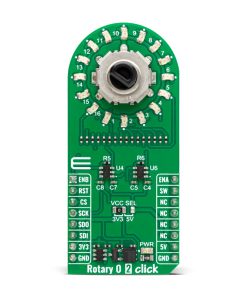Rotary O 2 Click
R415.00 ex. VAT
Rotary O 2 Click is a compact add-on board that allows you to add a precision input knob to your design. This board features the TLC5925, a low-power 16-channel constant-current LED sink driver from Texas Instruments that, combined with a high-quality rotary encoder from ALPS, the EC12D1564402, allows you to add a precision input knob to your design. It also features an LED ring composed of 16 individual orange LEDs that can visually represent the encoder position and more. This Click board™ makes the perfect solution for the development of various interesting visual effects for any application, such as flexible position, value indicator, and more.
Rotary O 2 Click is fully compatible with the mikroBUS™ socket and can be used on any host system supporting the mikroBUS™ standard. It comes with the mikroSDK open-source libraries, offering unparalleled flexibility for evaluation and customization. What sets this Click board™ apart is the groundbreaking ClickID feature, enabling your host system to seamlessly and automatically detect and identify this add-on board.
Stock: Lead-time applicable.
| 5+ | R394.25 |
| 10+ | R373.50 |
| 15+ | R352.75 |
| 20+ | R339.47 |


























